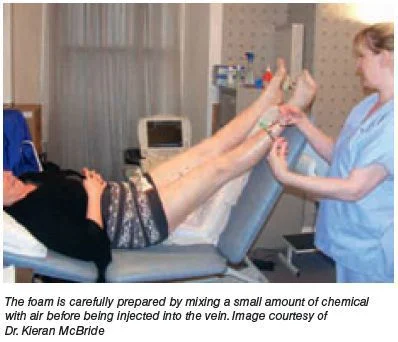HealthManagement, IQ_2012_06_venus
A third minimally invasive treatment option is foam sclerotherapy, which acts differently to the thermal ablative techniques. Dr. Kieran McBride, who runs a private vein clinic in Edinburgh, Scotland, talks us through its uses and advantages. “There is certainly a role for foam sclerotherapy in treating varicose veins, as well as other venous malformations. While laser has shown to be the most effective of the ablation techniques, ablation is only one part of the procedure. Once the main trunk of the vein has been closed, you often have to follow up and deal with the branch veins – twisty little veins that you can’t put a fibre-optic into.”
The Treatment
“The procedure is carried out in a similar manner to ablation, but the active ingredient is different. We use image guidance, usually ultrasound, to place a catheter or need le into the affected vein. We then inject a sclero - sant – a detergent that dissolves the lipoproteins in the lining of the vein. So you effectively do a chemical burn, dissol ving the vein wall so that blood stops flowing in it. That’s followed with compression therapy, so we put patients into bandaging and stockings to get a better result.”
The Foam
“To make the foam, we mix a small amount of chemical with air. A very small amount can actually treat an awful lot of vein, because it expands, pushing the blood out of the way. We then use the transducer and push the foam where we want it to go, and it stays preferentially in those very superficial veins. A small volume may go into the deep veins, but the patient’s leg is elevated, and I usually get them to flex their ankle 20 times and massage their calf afterwards, which washes that small volume of chemical away. So it doesn’t have any direct effect on the deeper veins. The incidence of deep vein thrombosis (DVT) following foam sclerotherapy is actually very small: about 20 in 12,000 shown in a French study.”
A Safe Option
“The safety record is absolutely impeccable: minor symptoms, such as blurry vision or tightness in their throat, occur in about 5% of patients. Our clinical watchdog in the UK, NICE, has approved it, and I think it offers patients a great alternative to vein stripping.”
The Attraction of Sclero Therapy
“As I said, this therapy is very valuable for secondary treatment. In my clinic in Fife, we use foam for recurrent veins, which are typically small branches. To surgically re-operate on veins that are recurrent can be quite complicated, and it’s got a recurrence rate itself. Between 20% and 40% of patients that are re-operated on can get complications: wound infections, haematomas, nerve da mage, or lymphatic damage. So doing laser and doing foam on these recurrent patients is the logical approach. “Foam sclerotherapy is also valuable as a primary treatment. Injecting foam into the main trunk of a vein has a closure rate of 70-80% – the difficulty here is that those veins are bigger, so you have to use larger volumes of foam, and the complications of foam are related to the vo lume that you use. But while the closure rates aren’t as im pressive as for ablation, there are still many cases where it is eminently more suitable. If a patient presents with very knotted, twisted varicosities, you might not be able to get a straight laser through those bendy veins. That’s where sclerotherapy presents a very attractive option – the foam can spread out to reach all the little nooks and crannies.”



